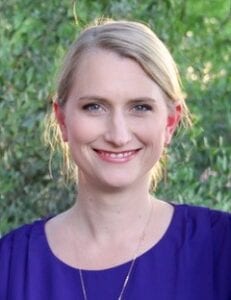Posted By: Sarah Ratzel, PhD, Science Editor, AJHG
Each month, the editors of The American Journal of Human Genetics interview an author of a recently published paper. This month, we check in with Casey Romanoski to discuss her paper, “Systems Genetics in Human Endothelial Cells Identifies Non-coding Variants Modifying Enhancers, Expression, and Complex Disease Traits”.

AJHG: What caused you to start working on this project?
CR: This project is the natural culmination of my diverse training environments and innate interest in the genetics of endothelial cells (ECs). ECs are the cells that line all blood and lymphatic vessels. They mediate transfer of nutrients and immune cells into underlying tissues and are highly responsive to the forces of blood flow. Whereas I have applied singular aspects of this work in other contexts, this project integrates several complementary approaches and datatypes with the end goal of linking functional variants to their regulatory, expression, and disease consequences.
AJHG: What about this paper most excites you?
CR: I am very excited by that, despite the profound complexity of biologic systems, we are able to discern sequence variants whose effects can be traced across multiple omic layers: from DNA to chromatin to expression to disease using integrative analysis of unbiased ‘omic data. Further, we did this this in a cell type that exists in nearly every tissue of the human body and is central to health and disease. Although in reality we can ‘explain’ only a fraction of the true cross-omic relationships that exist, the idea that we can do this at all excites and motivates me to push the envelope to accelerate future discovery.
AJHG: Thinking about the bigger picture, what implications do you see from this work for the larger human genetics community?
CR: To me, the implications are that integrative analysis of unbiased and complementary ‘omics datasets will enable improved understanding into molecular and systemic relationships. These are the relationships that exist among individual’s genomic sequences and the precise processes that are differentially manifested across individuals and in disease.
AJHG: What advice do you have for trainees/young scientists?
CR: Ask questions. Stay true to your own intuition and interests, and invest yourself in these endeavors. I hope all trainees will find something they are deeply interested in and persue it such that they have no problem answering the question, “What excites you about the research that you are doing?”.
AJHG: And for fun, tell us something about your life outside of the lab.
CR: I am fortunate to live in the beautiful Sonoran Desert in Tucson, Arizona. I spend a lot of time outdoors in the desert with my family — walking, swimming, and observing the natural world around us. I also practice yoga, which helps keep me centered in a busy life.
Casey Romanoski, Ph.D., is an Assistant Professor in the Department of Cellular and Molecular Biology at the University of Arizona.
